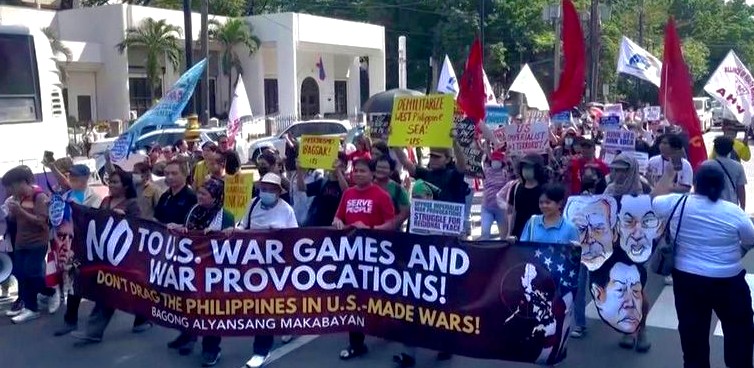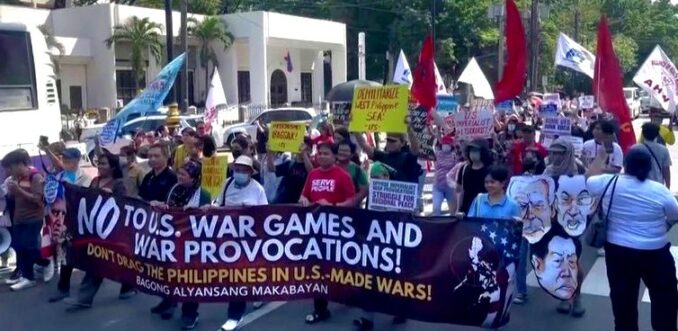

April 11 protest in Washington, DC. credit: Democracy Now!
President Joe Biden met with Japanese Prime Minister Fumio Kishima and the President of the Philippines, Ferdinand “Bongbong” Marcos Jr., on April 11. Dubbed as the “Philippines-U.S.-Japan Trilateral Summit,” the event was held in Washington, D.C.
While the White House claimed the meeting focused on “peace and security,” Biden’s own “tough-talk” description of the gathering could be perceived as a threatening gesture towards China and the Democratic People’s Republic of Korea, as well as all working-class and Indigenous peoples residing near the Indo-Pacific and South China Seas.
Following the assembly, Biden told reporters, “The United States defense commitments to Japan and to the Philippines are ironclad. They’re ironclad.” (AP news, April 11)


April 11 protest in Washington, DC. credit: Democracy Now!
The summit was met by a militant protest from a Philippine-led coalition that includes BAYAN USA, Malaya Movement USA and the Tuloy Ang Laban Coalition. Organizers of the event said they were particularly appalled by the showing of Marcos Jr., son of the former right-wing dictator, Ferdinand Marcos Sr.
The elder Marcos was president from 1965-86 and ruled the Philippine islands under martial law from 1972 until 1981, with the full blessing of U.S. and European imperialists. Many labor unionists and leftists disappeared and were gruesomely slain during Marcos’ “ironclad” rule.
While Marcos Jr. campaigned for president as a “moderate” in 2021 and 2022 when compared to his father, as well as his predecessor Duterte, protesters see his presence at the meeting with Biden and Kishima as selling out the people of the Philippines for profit and continued militarism.
Just one day before the summit, the U.S. and Japan made an official pact with Britain to conduct future joint military exercises in the Indo-Pacific in 2025. It is clear by the state leaders’ behavior that they are not interested in providing genuine “peace and security” for the people of the Asia Pacific.
RIMPAC 2024: a convergence intended for saber-rattling
The U.S. Third Fleet hosted a final planning conference for the Rim of the Pacific (RIMPAC) 2024 Exercise at the Point Loma Annex Naval Base in San Diego on March 25-28. RIMPAC is a gathering of military ships from two dozen countries that serves as the world’s largest international maritime warfare exercise.
The U.S., Britain, Canada, New Zealand and Australia’s navies were the first to participate in the initial RIMPAC fleet. Starting from the early 1970s, war game exercises have been held biennially. RIMPAC 2024 is scheduled to take place this June.
The U.S. has participated in every RIMPAC exercise since the first convergence in 1971, and the Pentagon largely coordinates the whole event. The U.S. Navy’s Indo-Pacific Command officially spearheads RIMPAC fleets, and it also receives assistance from the U.S. Marine Corps, Coast Guard and National Guard forces stationed in Hawaiʻi, which Washington seized from its Indigenous people in the 19th century. RIMPAC headquarters are in Hawaiʻi. Participants of RIMPAC exercises normally converge near the stolen shores of Honolulu.
This year’s RIMPAC exercise is expected to host battle ships from more than 25 countries. Israel, which is now carrying out a deliberate genocide, is among the countries permitted to take part.
Countries from different continents often request to send ships to RIMPAC, and not all are U.S. allies or clients, but Washington decides who participates.
Russia and People’s China are currently prohibited from having a presence at RIMPAC fleets. Russia took part in one RIMPAC exercise for the first and only time in 2012, but was quickly uninvited two years later after Russia refused to recognize the NATO-backed “Maidan” coup government in Ukraine in 2014.
Vietnam has participated in some RIMPAC gatherings even though early RIMPAC exercises targeted that pro-socialist country.
People’s China participated in a couple of RIMPAC gatherings over the years, but was officially barred in 2018. The removal of China from RIMPAC exercises came as Chinese people, especially in rural areas, were making material gains during President Xi Jinping’s leadership between 2013 and 2018. It is no coincidence China was disinvited from RIMPAC fleets just as millions of people in the country’s rural areas were emerging out of poverty.
South Korea, still occupied by U.S. troops, is a frequent participant of RIMPAC naval drills. South Korea is expected to attend this year’s war exercise, just as that country’s current president has made many aggressive maneuvers aimed at socialist Korea in recent months.
Washington’s claims it is not using the event as a forum for provocations against the governments of China, DPRK or Russia, but its actions tell a different story. That China, DPRK and Russia are not allowed to attend RIMPAC exercises, but Israel is, exposes the hypocrisy of U.S. leaders, along with the type of company they wish to keep. So much for improving “peace and security.”
Plans to confront RIMPAC 2024
Revolutionary activists with the International League of Peoples’ Struggle (ILPS) confronted the RIMPAC 2024 planning conference in San Diego. ILPS organized its own planning meeting on March 9, which was coined “Solidarity School.” The Solidarity School was a way to educate and agitate people around the impact of RIMPAC war games on people in the Indo-Pacific region, especially in the Philippines, as well as to strategize against RIMPAC 2024.
In addition to ILPS, another organization actively organizing against RIMPAC 2024 is the Hawaiʻi Committee for Human Rights in the Philippines (HICHRP). Organizers with HICHRP have for years tried to pressure the U.S. Congress to pass the Philippines Human Rights Act (PHRA), which would cut off military funding to the Philippines.
Like Israel and Ukraine, the government of the Philippines is a large recipient of U.S. “military funding.” According to figures reported by HICHRP in a Feb. 8 Counterpunch article, the U.S. government has sent more than $550 million of aid to the Philippine military and police since 2016.
Much of the money given the Philippine government has contributed toward the kidnappings, tortures and murders of trade unionists, environmentalists, leftists, progressive faith leaders and Indigenous peoples of the Philippines who are viewed as a threat to the U.S.-backed government.
The various organizers against the upcoming RIMPAC exercise find common ground in recognizing that U.S. imperialism poses the biggest threat to the global proletariat. As the U.S. Navy dominates the RIMPAC exercises, U.S. military leaders ultimately control who can attend the drills.
As people residing in the U.S. continue to face growing poverty, layoffs and life without a house — while being subjected to rising inflation and unaffordable medical costs — U.S. military political leaders are focused on showing off their newest naval weapons at RIMPAC maneuvers. Military weapons are U.S. capitalism’s most competitive manufactured goods on a global scale — and even that dominance is decaying.
Anti-imperialist activists should confront U.S. militarism wherever it rears its ugly head and call out imperialist representatives for their war provocations against the world’s working class and oppressed peoples, including in the Indo-Pacific region and join those who say, “Shut down RIMPAC 2024!”
Hamas issued the following statement on April 24, 2025, published on Resistance News Network. The…
By D. Musa Springer This statement is from Hood Communist editor and organizer D. Musa…
Portland, Oregon On April 12 — following protests in Seattle and elsewhere in support of…
This statement was recently issued by over 30 groups. On Friday, March 28, Dr. Helyeh…
When Donald Trump announced massive tariffs on foreign imports April 2, Wall Street investors saw…
The century-long struggle to abolish the death penalty in the U.S. has been making significant…